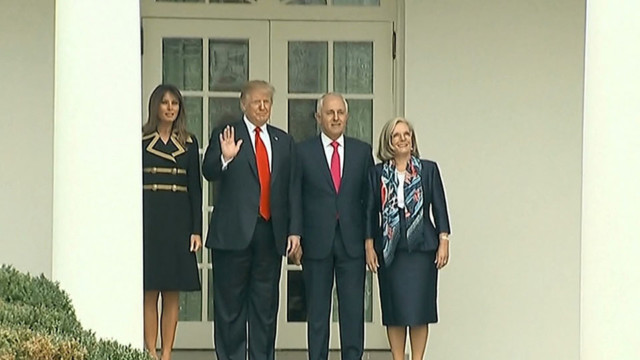U.S. President Donald Trump hosted Australia’s Prime Minister Malcolm Turnbull at the White House. The visit was a friendly one before cameras – in stark contrast to just a year ago.
CGTN’s Roee Ruttenberg reports.
Donald Trump and Malcolm Turnbull have a lot in common.
Both are multi-millionaires turned conservative politicians who strongly promote pro-business policies, domestically and abroad. But while the Australian prime minister is a vocal proponent of the multinational Trans-Pacific Partnership agreement, the U.S. president pulled out of TPP negotiations during his first month in office.
Australia and 10 other countries are expected to sign a revised version of TPP next month. Nearly two dozen provisions that had been included at the behest of Washington have since been revised or removed.
At the White House on Friday, in a joint press conference alongside Turnbull, Trump suggested there was still room for the U.S. in the agreement.
“TPP was a very bad deal for the United States,” President Trump said. “It would have cost of us tremendous amounts of jobs. It would have been bad. There’s a possibility we would go in, but they would be offering us a much better deal.”
The Washington meeting comes as the two countries mark 100 years of what both leaders called their “mate-ship.” But last year, relations between the two leaders seemed, at times, less than friendly.
Eight days into office, Trump spoke by phone with Turnbull, reportedly berating the Australian leader for some of his policies before cutting short what was described as a “most unpleasant call.”
Then, Turnbull mocked Trump at a national press gala. “Donald and I, we are winning in the polls,” Turnbull joked. “We are winning so much. Not the fake polls – we aren’t winning in those. We are winning in the real polls.” The audience laughed as Turnbull continued. “I have this Russian guy. Believe me, it’s true.”
On the world stage, the two leaders have managed to find common ground, including a tough approach towards the Democratic People’s Republic of Korea, or DPRK. But they appear to disagree on how best to deal with an emerging China.
“We see China’s rise as being overwhelmingly a positive for the region and for the world,” Prime Minister Turnbull on Friday said.
“The critical thing of course is that rule of law is maintained. There are people that want to try to paint the United States and its allies like Australia as being against China in some sort of rerun of the Cold War. That is not appropriate. It’s not accurate.”
Trump was asked if he agreed with the assessment made in January by his Defense Secretary, James Mattis, in the National Defense Review, which labelled China a “revisionist” power. “China is tough, and they’re getting stronger,” Trump said. “They’re getting stronger to a large extent with a lot of the money they’ve made from having poor leadership in the United States.”
On trade, Trump said he believed in the principle of reciprocity. “If they do something to us,” Trump said, “we do something to them.”
Trump was also asked if Australia should join the U.S. in so-called “freedom of navigation” exercises in the South China Sea, a move Beijing has criticized as unnecessarily provocative. In response, Trump said he would welcome Australian ships.
Earlier this month, Trump nominated a China hawk – Admiral Harry Harris, the Commander of U.S. forces in the Pacific – to be Washington’s new ambassador to Canberra. The move was seen, in part, as a message to Beijing.
Still, Trump lauded his personal friendship with Chinese President Xi Jinping, and said relations between the U.S. and China are better than ever.
Turnbull’s relationship with China – Australia’s biggest trading partner – is a bit rockier. In December, the prime minister said his government would introduce new measures to prevent alleged Chinese interference in Australian politics. Beijing rejected the accusation, and lodged an official complaint.
 CGTN America
CGTN America

